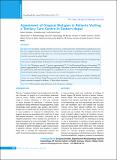Please use this identifier to cite or link to this item:
https://hdl.handle.net/20.500.14356/1298Full metadata record
| DC Field | Value | Language |
|---|---|---|
| dc.contributor.author | Shrestha, Sajeev | - |
| dc.contributor.author | Goel, Khushboo | - |
| dc.contributor.author | Niraula, Surya Raj | - |
| dc.date.accessioned | 2023-05-04T10:08:47Z | - |
| dc.date.available | 2023-05-04T10:08:47Z | - |
| dc.date.issued | 2020 | - |
| dc.identifier.citation | ShresthaS., GoelK., & NiraulaS. R. (2020). Assessment of Gingival Biotypes in Patients Visiting a Tertiary Care Centre in Eastern Nepal. Journal of Nepal Health Research Council, 18(3), 472-477. https://doi.org/10.33314/jnhrc.v18i3.1410 | en_US |
| dc.identifier.issn | Print ISSN: 1727-5482; Online ISSN: 1999-6217 | - |
| dc.identifier.uri | http://103.69.126.140:8080/handle/20.500.14356/1298 | - |
| dc.description | Original Article | en_US |
| dc.description.abstract | Abstract Background: Evaluation of gingival biotype has become a routine procedure in periodontal examination because the type of gingival biotype can positively or negatively affect the outcome of periodontal, restorative, orthodontic and implant therapy. The aim of the study was to assess the proportion of types of gingival biotypes in patients visiting a tertiary care center in eastern Nepal. Methods: Two hundred and fifty patients between 25 to 45 years attending the Periodontology and Oral Implantology were assessed. Gingival biotype of the patents was determined with Probe Transparency technique Results: Out 250 patients assessed, 73 patients (approximately 29.2 %) had thin gingival biotype and remaining 177 patients (approximately 70.8 %) had thick gingival biotype. The number of the male with thin biotype was 31 whereas the number of the male with thick biotype was 82. Similarly, out of 137 female, 42 had thin biotype and remaining 95 female had thick biotype. The types of biotypes were not associated with gender (p=0.67). Conclusions: Thicker gingival biotype was the more common type of gingival biotype in patients attending the tertiary care center of Eastern Nepal. The occurrence of thick gingival biotype was more common in Adivasi Janajati ethnic community compared to Brahmin / Chhetri ethnic community. Keywords: Adivasi janajati; gingival biotype, probe transparency technique | en_US |
| dc.language.iso | en | en_US |
| dc.publisher | Nepal Health Research Council | en_US |
| dc.relation.ispartofseries | Jul-Sep 2020; | - |
| dc.subject | Adivasi janajati | en_US |
| dc.subject | Gingival biotype | en_US |
| dc.subject | Probe transparency technique | en_US |
| dc.title | Assessment of Gingival Biotypes in Patients Visiting a Tertiary Care Centre in Eastern Nepal | en_US |
| dc.type | Journal Article | en_US |
| local.journal.category | Original Article | - |
| Appears in Collections: | Vol. 18 No. 3 (2020): Vol. 18 No. 3 Issue 48 Jul-Sep 2020 | |
Files in This Item:
| File | Description | Size | Format | |
|---|---|---|---|---|
| 1410-Manuscript-18844-1-10-20201115.pdf | Fulltext Article. | 300.46 kB | Adobe PDF |  View/Open |
Items in DSpace are protected by copyright, with all rights reserved, unless otherwise indicated.
